Once you’ve figured out what kind of kimono is appropriate for your event or lifestyle, you’ll need to pair it with an obi. Deciding which kind of obi to wear can be even more overwhelming than picking the kimono. Hopefully this will help guide you in the right general direction!
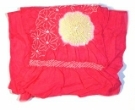 | Heko Heko obi are very casual, and are used primarily by children wearing yukata. It’s starting to become more common for adults to wear them, but again they’re in a very casual context. They are the only obi that is very soft and flowing, and almost looks more like a delicate scarf than any other obi. They’re typically tied in loose, flowing bows. |
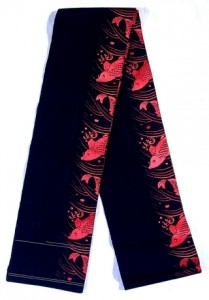 | Hanhaba Hanhaba essentially means “half width”, and that is exactly what these obi are. Most obi need to be folded in half while wrapped around the waist, and start out at a measurement of approximately one foot or 30cm wide. Hanhaba obi are half this width, and are generally much easier to tie in all sorts of cute musubi (bows). They’re normally quite casual, but every so often you can find one made of finer, more solid fabrics that are more appropriate for slightly dressier kimono. |
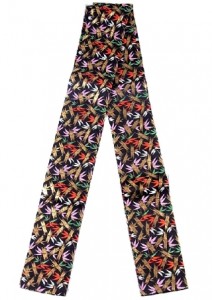 | Tenga These are a relatively new and not-so-common obi that are the size of hanhaba, but tend to have a lot of metallic brocade or embroidery and celebratory motifs. They can be worn with more formal kimono than a regular hanhaba would. |
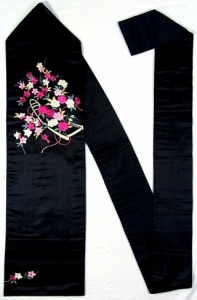 | Nagoya Nagoya obi have a very distinctive shape, they are narrow for approximately two thirds of the length and then they flare out to full width for the end. This makes them much easier to wrap around the waist, but still able to tie a slightly dressier musubi like otaiko or tsunodashi. They can vary from quite casual to quite dressy. Casual nagoya obi are often a solid colour with a small design embroidered or painted on the section that ends up on the front of the waist, and another coordinating design that ends up on the back of the drum bow. More dressy nagoya obi tend to have an all-over pattern and can often include metallic threads. Sometimes the wider end will also be long enough to tie a very formal drum like the niijudaiko. The type of kimono they can be worn with depends on the formality of the kimono. |
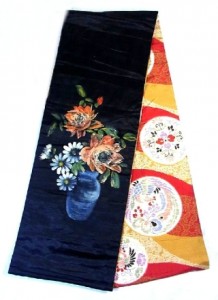 | Chuuya Literally night-and-day obi, chuya have fallen out of favour. They were very much in style during earlier eras, and are typefied their reversible duality – pale sublte “daytime” designs on one side and dark or more vivid “nighttime” designs on the other. They may also be patterned on one side and solid black on the other. These obi are 12″ wide, like fukuro, and can be used in a fair number of musubi, but due to the fact that they are generally nearly 100 years old, they tend to be slightly fragile. They are also often softer and “floppier” than modern wide obi, which adds a bit of casual feel to an outfit. |
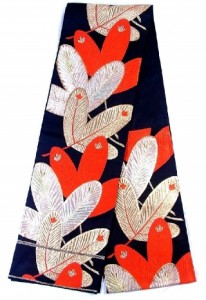 | Fukuro The longest obi, and therefore the easiest to tie fun and funky musubi with. They are the same width, approximately 30cm, the entire length. They are generally patterned on only 60% of the obi – the parts that remain hidden are solid to save on weight and money. Higher-end fukuro obi may be fully patterned. They are generally worn with furisode, houmongi, and tomesode, but can also be paired with iromuji and tsukesage in certain situations. |
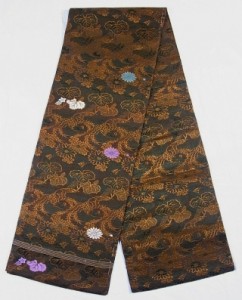 | Maru Maru obi are are the most formal obi. They are fully patterned on both sides, and often contain a fair bit of metallic brocade. Patterns can be either very tiny scale (typically seen on much older maru obi) or quite bold and large (more modern). They can be worn with any formal kimono, however they are usually a bit shorter than fukuro obi, which makes tying furisode-appropriate musubi a bit of a challenge. |
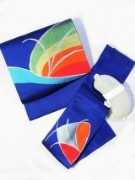 | Tsuke-obi, also known as tsukuri obi or easy obi These are kind of an odd duck. They are pre-tied, generally in two pieces. One narrow part ties snugly around the waist, and then a tied bow or knot tucks into the back. They’re used by women who don’t have a lot of experience dressing, women in a rush, or people who have to do frequent and quick costume changes like dancers or theatre performers. You can’t lump tsuke obi into one formality category, as they exist in nearly every level; from casual yukata obi to heavy gold fukuro obi in elaborate musubi to darari-style (see below) for dances and cosplay. Some people consider them “cheating”, but I consider them a good way to save a few minutes, or a good way to salvage an old or stained obi that would otherwise be unuseable. I am in the process of converting one myself, and will post the results once I am satisfied with them. |
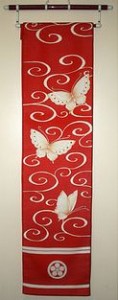 | Darari Darari, or dangling obi, are worn strictly by maiko, or apprentice geisha. They are more than twice as long as a regular obi, and will nearly always have the mon (crest) of the geisha house the maiko lives at on one end, to help identify where they are from. The patterns are always bold and vibrant, much like the maiko themselves. They are tied in a manner also referred to as darari, with two long hanging tails that remind me of folded butterfly wings. *Darari obi image used with permission courtesy of Christina Stoppa/GoldenPhoenix/Kurokami |
*Thanks to Ichiroya for the permitted use of their images. Originally these items were all available for purchase and the images linked back to the sale listings, but they have been sold!

























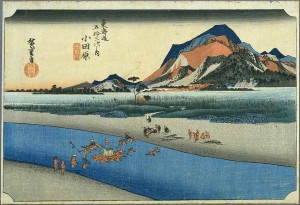

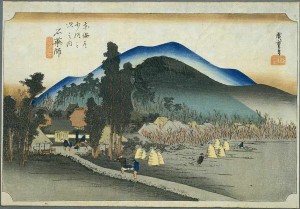

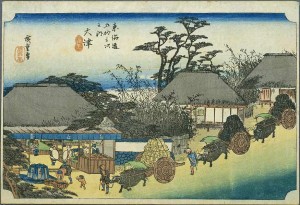

























 Bebe Taian
Bebe Taian CHOKO Blog
CHOKO Blog Gion Kobu
Gion Kobu